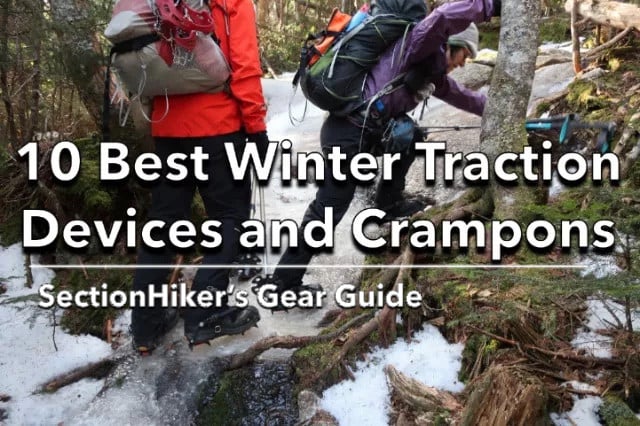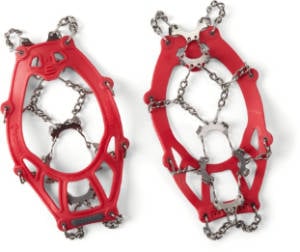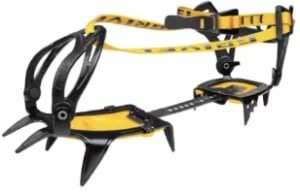
Winter hiking often requires the use of traction aids like microspikes or crampons that give your feet a better grip on ice and packed snow, while increasing your safety by preventing slips and falls on hard ice. The products listed below are designed for use in increasingly demanding conditions ranging from packed snow and icy trails to non-technical mountaineering over ice, snow slab, and rock. All of them can be used with soft-soled boots and trail runners as well as more conventional mountaineering boots with rigid soles and toe or heel welts.
| Make / Model | Best For |
|---|---|
| Kahtoola Microspikes | Packed snow, icy trails |
| Hillsound Trail Crampon Ultra | Packed snow, icy trails |
| Hillsound Trail Crampons | Packed snow, icy trails |
| Black Diamond Distance Spikes | Packed snow, icy trails |
| Hillsound Trail Crampon Pro | Mixed ice, snow, and rock |
| Kahtoola K10 Crampons | Mixed ice, snow, and rock |
| Kahtoola KTS Crampons | Mixed ice, snow, and rock |
| Black Diamond Contact Strap Crampons | Non-technical mountaineering |
| Petzl Irvis FLexlock Crampons | Non-technical mountaineering |
| Grivel G10 New Classic Crampons | Non-technical mountaineering |
Be sure to read our Winter Traction Devices and Crampons FAQ below about the characteristics of these winter traction devices and how to choose the right ones for your adventures. You frequently have to carry more than one, including snowshoes, depending on the conditions you’ll encounter on extended winter hikes.
1. Kahtoola Microspikes
| Shop at REI | Shop at Amazon |
2. Hillsound Trail Crampon Ultra
3. Hillsound Trail Crampons
| Shop at REI | Shop at Amazon |
4. Black Diamond Distance Spikes
| Shop at REI | Shop at Amazon |
5. Hillsound Trail Crampons Pro
6. Kahtoola K10 Crampons
| Shop at REI | Shop at Amazon |
7. Kahtoola KTS Crampons
| Shop at REI | Shop at Amazon |
8. Black Diamond Contact Strap Crampons
9. Petzl Irvis FlexLock Crampons
| Shop at REI | Shop at Amazon |
10. Grivel G10 New-Classic EVO Crampons
| Shop at REI | Shop at Amazon |
Winter Traction Devices and Crampons FAQ
If you’ve never used winter traction aids or crampons, it can be quite confusing to understand what you need and when to use it. Here are answers to some of the most common questions people have, but if you have others, please ask away in the comment section below and we’d be happy to answer them.
I’ve just started winter hiking, what do I need to buy?
Start with Kahtoola Microspikes or Hillsound Trail Crampon Ultras. If you hike in more mountainous terrain, I’d recommend getting Hillsound Trail Crampon Pros or Kahtoola KTS Crampons. If you need to snowshoe, buy those too. That will cover most of the bases.
What are microspikes?
Microspikes, also called trail crampons, are winter traction aids that act like tire chains for your boots or trail shoes. They usually have 1-1.5 cm spikes attached to chains with elastic harnesses that slip onto your footwear. They are best suited for hiking on packed snow and icy trails but are uncomfortable for walking on paved surfaces.
What is the difference between microspikes and crampons?
The primary difference between microspikes and crampons is the length of the spikes they have. Microspikes, also called trail crampons, have 1-1.5 cm spikes, while crampons have spikes that are up to 5 cm in length. Microspikes are used for hiking on packed snow and thin ice, while crampons are used for hiking on thicker ice, rock, and snow slabs.
Do you need to carry multiple winter traction devices on hikes or is one sufficient?
It really depends on where you are hiking and what the conditions are. But for lengthy winter hikes at multiple levels of elevation (ie. mountainous terrain), it is often necessary to carry microspikes, crampons, and snowshoes so that you have the correct level of traction or flotation for the surface conditions you’re likely to encounter. Too much traction, and you’ll wear yourself out by strapping heavy traction aids to your feet or twist an ankle because you used a mountaineering crampon when microspikes are more appropriate.
Do microspikes wear out?
Microspikes do wear out over time and the tops of their triangular spikes become flattened, providing less grip on ice. You can sharpen them with a mill bastard file, but eventually, they will have to be replaced.
What are rock spikes?
Rock spikes are microspikes that have worn out. Many hikers keep them around for use in early winter or spring conditions when hiking trails still have a lot of exposed rock and a thin coating of ice in order to preserve their newer and sharper microspikes for winter use on thicker ice and packed snow.
What is the difference between ice cleats and microspikes?
Ice cleats and ice screws are less penetrating than microspikes and suitable for more casual home or urban use. Ice cleats are often part of a strap-on overshoe to provide it with more traction.
What is an elastomer binding?
Microspikes and trail crampons have a stretchy, elastic binding that can accommodate all types of footwear, from soft-soled winter hiking boots and trail shoes to more rigid soled mountaineering boots. The elastomer remains flexible down to -20F and is highly durable for extended use.
What is a ratchet-style crampon harness?
A ratchet-style binding, like on Hillsound’s Trail Crampon Pro, is similar to a snowshoe binding where ridged straps are fed through a buckle that locks them in place. The advantage is a very secure fit, which is important on a crampon, and the ability to tighten the binding on the fly while wearing gloves.
What is an instep crampon?
An instep crampon usually has 4-6 spikes and attaches to the instep of hiking footwear. While it does provide added traction and they are very lightweight, it’s very difficult to balance yourself when walking up slopes or over rocky surfaces. They were used in the early days of mountaineering before crampons or microspikes became popular.
Do microspikes come in multiple sizes?
Microspikes also called trail crampons, come in different sizes based on your boot or shoe size. It’s important to fit them correctly to footwear to prevent discomfort or friction from using microspikes that are too small. The same holds for microspikes which are too large, can pop off your shoes, and are easily lost.
Can you walk on the pavement with microspikes?
While microspikes are made with stainless steel and are very durable, they’re not intended for walking on pavement or city sidewalks. You’re better off getting a pair of ice cleats or Yaktrax for that purpose.
What is the difference between microspikes and crampons?
Crampons have much larger spikes designed to penetrate deep ice on surfaces where falling is never an option. Microspikes have shorter spikes that provide a good grip on ice surfaces but are less penetrating. They also have a binding system, usually an elastomer harness, that is compatible with multiple footwear types, while crampon/footwear compatibility is more limited.
What are anti-balling plates?
Anti-balling plates also called balling plates, ABS plates, or snow release skins, prevent wet snow from clumping to the bottom of a winter traction device or crampon. This occurs when the crampon comes into contact with water or wet snow. Balling under a crampon is dangerous because it prevents the crampon spikes from gaining traction. Instead, you slip over the surface of the snow or ice out of control.
Do you need to wear gaiters with microspikes or crampons?
High mountaineering gaiters are designed, in part, to protect your legs from the sharp points of your crampons and usually have reinforced lowers to prevent spike penetration. They’re not really necessary for protection when wearing microspikes because their spikes are much shorter. Still, gaiters also prevent your pants from getting wet in deep snow and can be worn for that purpose alone.
What is the difference between a steel crampon and an aluminum crampon?
Steel crampons are much more durable than aluminum ones and are easier to sharpen when they’ve been worn down. However, aluminum crampons are very lightweight and can weigh half as much as steel crampons, making them useful when the lightest gear weight is required.
What is a step-in crampon binding?
Step-in crampon bindings attach to special ridges, called welts, that are cut into the soles of mountaineering boots. The step-in bindings have hinged metal bars that slot into the welts and form a very tight connection with the boots. Step-in bindings are used for higher-angle mountaineering or ice climbing where you need a very secure attachment.
What is a flexible leaf spring?
The metal bar connecting the front and heel portion of a crampon are usually rigid when the crampon is used with a stiff-soled mountaineering boot. It should be replaced with a flexible metal bar called a leaf spring, which lets the two halves of the crampon, the front and back, move independently when the crampon is used with a soft-soled boot or trail shoe.
How do you walk on ice with crampons?
When you walk in crampons you want to make sure that all of your spikes are in contact with an icy surface and digging into it. This may involve bending your ankle and leg to keep the spikes in continuous contact or stomping down on the ice as you walk. This prevents you from sliding and falling,
Can you walk on rocks with crampons?
It is often necessary to walk on rocks with crampons in mountainous terrain. You should do so carefully to avoid twisting an ankle and try to keep the surface of your foot as flat or perpendicular to the rock as possible.
See Also:
- Winter Traction and When to Wear It
- Hillsounds or Microspikes: How to Choose
- Hillsound Trail Crampons: How to Choose
- Camp Stalker Universal Crampon Review
- Hillsound Cypress 6 Instep-Style Crampon
- Black Diamond Contact Strap Crampon
- CAMP Nanotech XLC Crampons Review
- STABILicers Hike Macro Winter Traction Spikes Review
- Yaktrax Summit Winter Traction System Review
- How to Use Crampons
 SectionHiker.com Backpacking Gear Reviews and FAQs
SectionHiker.com Backpacking Gear Reviews and FAQs 









Phil thanks for your excellent timed article. I was out hiking Chocura yesterday and thinking that I needed to add some more traction to my winter gear before the snow starts flying. I currently have microspikes and Lightning Ascent snowshoes but a few times I found I needed to get up something fairly steep like iced in ladders on the Osseo trail and the snowshoes just didn’t cut it and the microspikes were absolutely no help. So I’m looking at the Hillsound Pros the K10 and the KTS. My winter boots are a set of Solomons which are semi-rigid definitely not Trail Runner soft but not mountaineering boots either. between the three I mentioned which do you like best.
The Hillsound Pros. The front binding is designed for a boot. Just make sure that the heels fit between the posts in the back before you go hiking with them. The others are really designed for smaller toe boxes.
Since I live further south in middle-Appalachia, I find Kahtoola EXOspikes ideal for Spring and Fall, when we get thin but dangerous sheets of ice. The traction is provided by 12 knobs tipped with steel pieces that look like the tips of trekking poles. The harness is the same as Microspikes. EXOspikes are lighter and more comfortable when you don’t need bigger spikes and keep you closer to the ground. In fact, I think they’re safer, since I see people losing their balance trying to walk across bare rock still wearing their longer spikes, since it is such a hassle to constantly put them on and take them off. EXOspikes would also work well on icy pavement.
Thanks for this. I picked up some of the BD distance ones after seeing them here.
I love the design of that product. They really nailed it.
I just got the hill sound trail crampons. I do some of the white mountain hikes also, especially Franconia Ridge, when the conditions are not nearly so tough as your recent December hike. Would the problem with snow balling be big enough so that I should get an anti-balling alternative?
Snowballing only occurs when you get your crampons or snowshoes wet with liquid water. So avoid that, although that’s hard to do on the Franconia Loop at the bottom. I think you’ll find some days where trail crampons are insufficient on Franconia Ridge. We really barely got by with them in December when the ice is thinnest. When choosing heavier traction you should be thinking about slope angle, spike length, and spike sharpness a lot more than snowballing. You can always stomp snowballs off crampons or whack them off with trekking poles. But you can’t get a deep bite on a steep slope with trail crampons. You need more depth to get a good plant in the ice.
Walking with full crampons is a skill. You can’t just put them on and expect to be an expert. Get someone to show you how to keep your points in the ice no matter the steepness. I’d even go so far as to recommend an intro to mountaineering course so you can learn how to use an ice axe too. I usually carry crampons and an axe on Franconia Ridge in true winter conditions.
I was not talking about true winter conditions. Perhaps I should’ve clarified things better. I am interested in hiking on a sunny day in April, with snow on the ground, and not under true winter conditions at all. Those conditions are the ones that I am interested in for traction devices . I have done the Franconia loop with Kahtoola, micro spikes, in this sort of weather, but thought I would like something that is a step up.
For around town an old pair of running shoes with sheet metal screws as studs work great. Search the web for hints.
Just don’t wear them inside the house and don’t forget to take them off before coming inside.
snowline Chainsen Pro work well for me.
They look just like the Hillsound Trail Crampon Ultra
Maybe same company? About $20 less expensive though.
Buy whatever REI sells. All microspikes and trail crampons break eventually, but if they go within a year and you’re an REI member you can exchange them for a new pair.
I see Yak trax available everywhere, but not on this list. Do they even compare at all to this list, and are they not recommended for hiking at all? I’m looking to up my game winter hiking in Minnesota where winters are looooooooooong.
I would not recommend them.
Read other peoples choices.
Mine did not last long
Yaktrax break the second you try to hike in them. They’re a joke only good for walking down the driveway and even that may be a stretch.
Yaktrax kinda suck. They’re OK for a walk around the block, but are next to useless for hiking.
Cathie W,
I’m guessing that those who have replied to you thus far are referring to the YakTrax Pro which is their “wire-coil” style traction device. It’s true that they are only for light duty (around town, easy maintained type trails, etc). However, I have been using a single and original pair of the YakTrax Ascent’s (similar to the Kahtoola Microspikes) for several years in the Colorado Rockies and they still look and perform like brand new. I’ve used them to scramble and summit more than a couple dozen mixed ice/rock 12ers and 13ers and I’ve never come close to slipping on the way up or the way down! I think it’s important to compare apples to apples when researching. Oranges just taste different!
Yaktrax Ascent Heavy Duty Traction Cleats with 16 Stainless-Steel Spikes (1 Pair) https://amzn.to/3GrmaWA
They make a million different varieties. I’ve tried quite a few and destroyed all the lighterweight ones quickly. too quickly. The Ascents are essential equivalent to microspikes, but the Yaktrax Summits are more Hillsound Trail Crampons. I don’t particulary like the Summits because I don’t like a boa binding very much and because the Summits are not field repairable. Tomorrow’s article describes how to repair Kahtoola Microspikes and Hillsound Trail Crampons…
When it comes to a full crampon, what would you recommend as the most versatile, since they can fit all sizes of shoes due to the length adjustment? Thinking something that primarily would be used with insulated boots like Salomon Quests or Oboz Bridgers, but could still be used somewhat comfortably in the short stretches of thick ice that is seen during shoulder season while still wearing trail runners? Would you still go with the Hillsound Pro’s as mentioned in the first comment?
If you want to use something with trail runners, I’d go with the Kahtoola K10 or KTS. The Hillsound pros work better with boots because the straps cross over your shins. That would be uncomfortable with a low shoe.